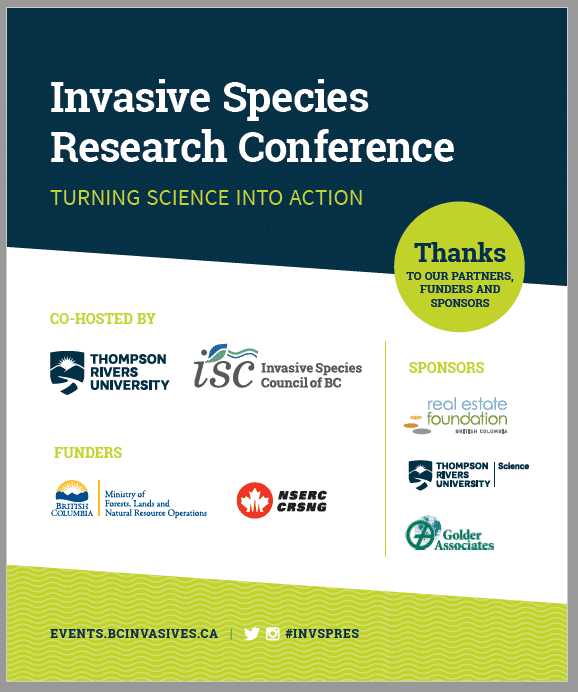Invasive Species Research Mini-Symposium
ISCBC’s first virtual Invasive Species Research Mini-Symposium was held on August 19th, 2020.
This virtual event was planned due to the postponement of the in-person 2020 Invasive Species Research Conference. The Mini-Symposium recording will be of particular interest to invasive species researchers, managers and practitioners from across the Pacific Northwest who can watch five North American invasive species experts from the comfort of their office, lab or home!
2020 Invasive Species Research Mini-Symposium
Session One, Where Invasive Species Monitoring and Genetics Meet, features two keynotes speakers: Dr. John Darling of the US Environmental Protection Agency and Dr. John Gaskin of the US Department of Agriculture’s Research Service. Learn about two ISCBC initiatives related to progressing invasive species research in BC and the Pacific Northwest. In Session Two, Climate Change and Invasive Species from a Pacific Northwest Perspective, three regional researchers provide ten-minute presentations on climate change and invasive species research in the Pacific Northwest: Dr. Shauna-Lee Chai, InnoTech Alberta; Dr. Angela Strecker, Western Washington University’s Institute for Watershed Studies and Dr. David Ensing, Agriculture and Agri-Food Canada. All five presenters joined the panel for a twenty-minute facilitated discussion.
Highlights
The Invasive Species Research Mini-Symposium brought together 224 people from the invasive species community in the Pacific Northwest and beyond. Attendees joined from nine countries including Canada, USA, Argentina, India, Mexico, Nigeria, Pakistan and Puerto Rico. The event included interactive elements such as asking attendees to show their location by dropping a pin on a live web-based location map.

Attendees were asked their relationship to invasive species:
- 55% worked in invasive species management
- 24% studied or were active in invasive species research
- 20% had an interest in invasive species
The majority of attendees were working or interested in terrestrial plants, followed by aquatic plants, aquatic invertebrates and terrestrial invertebrates but overall, attendees’ interests spanned all taxonomic groups.
After the five presentations and panel discussion, attendees were asked to share how they felt by posting one word in a web-based live word cloud.

Join the Invasive Species Research Hub
Make ongoing connections with the invasive species community in the Pacific Northwest. Join the Invasive Species Research Hub. Membership is free and members can search the database for researchers and practitioners in related fields. Members are also invited to connect and discuss topics using the communications platform Slack.
9:00 am SESSION 1: Where Invasive Species Monitoring and Genetics Meet
- Opening remarks and introductions
9:10 am Keynote Presentation
- Molecular biosecurity surveillance: A case study in rapid evolution; Dr. John Darling, US Environmental Protection Agency’s Office of Research and Development
9:50 am Virtual Break
10:00 am Keynote Presentation
- Using genetics to inform invasive weed management; Dr. John Gaskin, US Department of Agriculture’s Research Service
10:50 am Virtual Break
11:00 am SESSION 2: Climate Change and Invasive Species from a Pacific Northwest Perspective
- A series of three presentations on research into invasive species and climate change by presenters based in the Pacific Northwest, followed by Q&A and panel discussion.
- Climate change considerations for invasive species management in the Pacific Northwest; Dr. Shauna-Lee Chai; Innotech Alberta
- New frontiers in understanding the response of aquatic invasive species to climate change; Dr. Angela Strecker; Western Washington University’s Institute for Watershed Studies
- Challenges and opportunities for biocontrol in a changing climate; Dr. David Ensing; Agriculture and Agri-Food Canada
12:10 pm Closing Remarks
12:15 pm Mini-Symposium Adjourns
Presenter Bios and Abstracts
Dr. John Darling
US ENVIRONMENTAL PROTECTION AGENCY’S OFFICE OF RESEARCH AND DEVELOPMENT

Molecular biosecurity surveillance: A case study in rapid evolution
Abstract: Many management actions aimed at mitigating the ecological and economic harms done by aquatic invasive species are predicated on detection. General risk management, prevention of new incursions, control and eradication of established invasive species, all depend on the ability to detect individual organisms, often when populations are at extremely low densities. The associated need for improved monitoring tools—those that are more accurate, more sensitive, more easily deployable, and less expensive—is increasingly driving the development of methods based on the capture and analysis of nucleic acids in the environment. This talk is about the trajectory of this rapidly growing field. I will discuss the past, present and future of these tools, examining the extraordinary gains already made, some growing pains that have accompanied rapid emergence of novel methods, and the hurdles—technological, logistical, and even political—that remain. I will examine how researchers and managers alike are addressing challenges such as the interpretation of genetic detections, the need for quantification of target populations, and the importance of assessing viability in certain monitoring contexts. I will also discuss how high throughput sequencing technologies can place invasive species detection within the context of broader assessments of biological communities, providing a powerful tool for researchers and managers to explore how various drivers, including climate change, alter those communities over time. I hope to present a case for the promise of these methods, which have the potential to vastly improve our capacity to manage aquatic invasions over the coming decade. In doing so, I hope also to encourage cross-disciplinary engagement in the development of genetic monitoring tools, to ensure that future tools are responsive to management needs.
Bio: John Darling is a Senior Research Biologist in the United States Environmental Protection Agency (EPA) Office of Research & Development. His science supports EPA’s Program Offices by advancing understanding of the risks associated with invasive species in marine and freshwater systems and developing tools aimed at improving EPA’s capacity to respond to those risks. Dr. Darling’s research focuses on the application of molecular genetic methods for assessing and mitigating exposure to aquatic invasions, with current emphasis on the utilization of high throughput sequencing and environmental DNA technologies for biosecurity surveillance and monitoring. He has published extensively on issues ranging from the genetic reconstruction of invasion histories to the implementation of molecular surveillance methods in complex decision-making contexts. Dr. Darling has served on multiple working groups and advisory panels at the state, national, and international levels and currently serves as US EPA’s representative to the US Aquatic Nuisance Species Task Force and as a US representative to the International Council for Exploration of the Seas working groups on ballast water and introduced marine species.
Dr. John Gaskin
US DEPARTMENT OF AGRICULTURE’S AGRICULTURE RESEARCH SERVICE

Using genetics to inform invasive weed management
Abstract: Genetic information can inform us of the taxonomic identity, diversity, population structure and origins of invasive species. It can also determine which mode of reproduction, such as sexual outcrossing, apomixes, or vegetative reproduction, is most commonly used in an invasion, and if there are any hybridization events occurring. Knowing these items can help us create more effective invasive plant management plans. Here I will discuss some new knowledge gleaned from genetic data for flowering rush, common mullein, and a new thistle species
Bio: Dr. John Gaskin received a BA in Biology at UC Santa Cruz, then a PhD in Evolution and Population Biology from Washington University in St. Louis. He currently manages the USDA Agricultural Research Service lab in Sidney, Montana. For the last 18 years the focus of his research has been the population genetics and molecular systematics of invasive plants. Specific goals of this research are to find out which genotypes of exotic plants are invading, where these plants originated from, which native and exotic species they are most closely related to, and where the invasive genotypes are distributed in North America. He also has a strong interest in hybridization and invasion, and how novel hybrids can influence invasion and resistance to biological control agents. His research intentions are to enhance biological control program efficacy by making sure that the genetic diversity of an invasion is represented in tests of current and proposed biological control agents, and that all native plants closely related to the invasion are included in host-specificity tests. Invasive taxa of interest include saltcedar, rush skeletonweed, hawkweeds, pepperweeds, Russian olive and teasel.
Dr. Shauna-Lee Chai
INNOTECH ALBERTA

Climate change considerations for invasive species management in the Pacific Northwest
Abstract: Climate is one of the biggest influencing factors for invasive species and pest distribution. Management tactics for coping with climate change can include risk assessments, consideration of expanded spatial and temporal scales, and drawing close to your neighbours and networks to gain intelligence and pool resources. 2020 is the year of COVID-19, but also the UN International Year of Plant Health which seeks to amplify efforts to protect plant health given climate change, travel and trade.
Bio: Dr. Shauna-Lee Chai is a Senior Research Scientist in Alberta. She graduated with a PhD in Plant Sciences from the University of Cambridge where she was a Bill and Melinda Gates Scholar. She has conducted significant research on invasive species issues over the past 15 years – first in Jamaica, where she researched the invasive white-tailed deer and implemented invasive plant control programs in a tropical rain forest national park. In Alberta, she has conducted invasive species risk assessments and needs assessments for the Alberta government.
Dr. Angela Strecker
WASHINGTON WESTERN UNIVERSITY

New frontiers in understanding the response of aquatic invasive species to climate change
Abstract: Invasive species tend to be tolerant of a wide range of environmental conditions. Thus, they are uniquely suited to dealing with and adapting to a changing climate. In freshwater habitats, climate change may facilitate colonization of aquatic invasive species (AIS) to new habitats, increase predation of AIS upon native species, shift the balance of competition between natives and invaders, increase disease transmission, increase habitat alteration, and reduce the efficacy of some control strategies. Scientists have used a variety of techniques to understand and predict how AIS will respond to climate change, including empirical studies, models, and both field and lab experiments. However, we still lack a mechanistic framework to integrate how the diverse effects of climate change on freshwater ecosystems will affect AIS. Providing managers and stakeholders with robust predictions about the potential spread and effects of AIS in the future needs to be a research priority.
Bio: Angela is the Director of the Institute for Watershed Studies and Associate Professor in the Department of Environmental Sciences at Western Washington. Prior to arriving at WWU, she was faculty in the Department of Environmental Science and Management at Portland State University and Director of the Center for Lakes and Reservoirs. She completed her Bachelor of Science degree with Honours in Biology at the University of Regina and a Ph.D. in Biology at Queen’s University. Angela has published 30+ peer-reviewed research articles, three book chapters, numerous reports, and >60 conference presentations. She has received grants from the National Science Foundation, Bonneville Power Administration, Washington Department of Fish and Wildlife, US Army Corps of Engineers, the National Landscape Conservation Cooperative, and the North Coast and Cascades Science and Learning Network. She is also an Associate Editor at the journal Aquatic Sciences.
Dr. David Ensing
AGRICULTURE AND AGRI-FOOD CANADA

Phenological mismatches influence biocontrol efficacy in a changing climate
Abstract:
Climate change has caused shifts in the spatial distributions of species and in the timing of their life history events. However, not all species respond to climate change in the same way, resulting in temporal mismatches between interacting species. Such phenological mismatches have been widely recognized between plants and their pollinators or between migrating vertebrates and their food sources. Less attention has been paid to how phenological shifts might result in mismatches between biocontrol agents and their target pest species, especially in weed biocontrol. In this talk I will describe the nature of this problem for biocontrol and outline key research and management directions for identifying mismatches, and adjusting to them to ensure effective control. I will close by highlighting examples where rapid evolution has limited mismatches, maintaining effective biocontrol. An understanding of the potential for rapid evolution of targets and agents in a changing environment is required for continued biocontrol efficacy.
Bio: David is a plant ecologist who specializes in understanding the ecological and evolutionary mechanisms underlying species distributions. He did his undergraduate studies at Okanagan College and University of BC’s Okanagan Campus, receiving an Honours degree in Ecology and Evolutionary Biology from UBC-O (2011). Productive collaborations in hawkweed biological control and developing research questions prompted him to stay on at UBC-O for his Masters in Biology with Dr. Jason Pither studying plant community ecology under rangeland grazing (2013). David then moved to Queen’s University for his PhD with Prof. Chris Eckert (2019), which involved three summers of extensive, plant ecological fieldwork in the Kananaskis Valley of the Canadian Rockies studying phenological variation on steep elevational gradients of season length. Since arriving at Agriculture and Agri-Food Canada’s Summerland Research and Development Centre in April 2019, he has brought his extensive expertise conducting widespread observational surveys and experimental tests of phenotypic variation in invasive and native plant populations to bear on the problematic and persistent rangeland invader, spotted knapweed (Centaurea stoebe ssp. micranthos) across southern BC.














